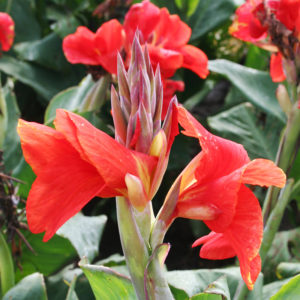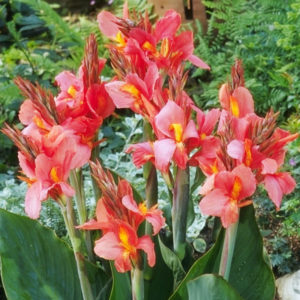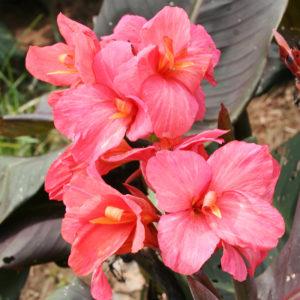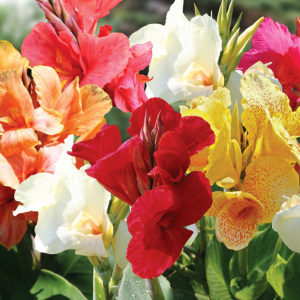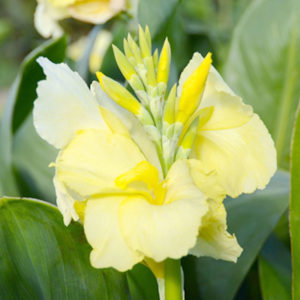Bold, tall, and colorful! Those are the words I associate with canna lily bulbs and canna plants. Canna lilies are tropical bulbs that grow from a rhizome. They are known for their bold foliage in varying colors, bright blooms, and stately growth habit.
Gardeners in warm climates may be very familiar with canna lilies as they are perennials and easy to grow. For those who live in colder climates, they may have some knowledge of canna lilies. Fortunately, these tropical bulbs can be grown in most areas of the United States either as an annual or perennial. Whether you want to add a tropical flair to a northern garden or plant cannas in the heat of the south this guide will help you get cannas growing this summer!
How to Plant Canna Lilies
Canna Lilies can be grown from seed, potted plant, or a rhizome. Planting canna lilies from a rhizome is the most popular way to plant. Canna lily rhizomes are a type of bulb; all bulbs are underground storage units.
Rhizomes are horizontal underground storage units of energy where growth comes out of various points. These various growth points are called eyes. When you are purchasing canna lilies you will notice the size listed as 2/3 eye or 3/5 eye. The more eyes the larger the rhizome tends to be.
Canna lily bulbs should be planted at a depth of 2-3”. Therefore, you will want to use a garden trowel or bulb auger to excavate 2-3” deep and two times the width of the rhizome. Place the canna lily bulb at the bottom of the 2-3” planting area. Cover the rhizome with soil. You may add water initially upon planting. However, until you see above ground growth you will want to keep the canna lily bulbs and planting area on the dry side. Excessive moisture prior to the bulbs sprouting often leads to the rhizomes rotting.
When is the Best Time to Plant Canna Lily Bulbs?
Canna Lilies are native to tropical climates of North and South America. Due to their native habitat, they thrive in hot temperatures. The best time to plant canna lilies is in spring or early summer.
When your soil has warmed up to above 55 degrees it is safe to plant canna lilies. Your soil should be warm and moist but not saturated. Planting canna lilies in soil that is cold and damp will result in the rhizomes rotting.
If you aren’t sure what your soil temperature is, a good rule of thumb is that once the danger of frost has passed in your area it is safe to plant canna lilies.
For gardeners in colder climates who don’t want to wait until June to get their canna lilies planted, they should consider starting them indoors. To start your canna lilies indoors you will need a container with drain holes and a good planting mix. You can get your canna lilies started in pots and protect them from the cold and damp conditions they don’t favor in spring. Once the rhizomes have sprouted and the danger of frost has passed you can transplant your potted canna lilies into the garden.
Where to Plant Canna Lilies?
Canna lilies like it hot and humid. They will thrive in hardiness zones 7 and above. In hardiness zones 8 and above they are considered perennials. Gardeners in zones as low as hardiness zone 3 can grow canna lilies as annuals.
When selecting a location to plant canna lilies in your garden the first thing to consider is how much sun the area gets. Canna lilies thrive on the sun and grow best in areas that get 8 or more hours of sun a day. At minimum canna lilies require 6 hours of full sun to perform well.
Canna lilies will tolerate moist soil once the plants have sprouted from rhizomes. However, if you are planting the rhizomes directly in the ground you will want to make sure the soil has adequate drainage.
These tropical-looking bulbs have a strong vertical habit. They can grow 6’ tall or more in proper growing conditions. Some varieties are considered dwarf and only grow 2-3’ tall. Once you have found your sunny garden section consider the height of the canna you will be planting. Make sure it won’t be too tall or too short for the location.
Planting Canna Lilies in Pots
Canna lilies are popular plants for containers. They can be used as the vertical accent in a mixed planting container that has other flowers planted in it, that fill and spill over the edges. Canna lilies can also be planted alone in a container as a bold statement. Dwarf Canna varieties like Shell Pink Canna, Yellow Futurity Canna, and Red Futurity Canna are best for planting in containers. However, if you have a large enough container, (at least 24″ diameter) you can certainly plant tall cannas in that type of planter.
Using Canna Lilies as a Screen
Due to their vertical habit and relatively tall mature height canna lilies make an excellent screen. If you have a narrow space you would like to increase your privacy canna lilies can make a good short or long term screen depending on where you are located. Each canna lily rhizome you plant will grow 2-3’ wide at most which make them a great choice for tight spaces you need privacy. Tall cannas like Wyoming Canna, City of Portland Canna, and Red King Humbert Canna grow 6’ tall or more. 6′ or more is a good enough height to create separation, and increase privacy.
Canna Lily Colors
Both the flowers and foliage of canna lilies are full of color! The most common color of canna lily leaves is green. Canna lily varieties like Black Knight Canna, Wyoming Canna, and Red King Humbert Canna have deep purple to bronze-colored foliage. Stuttgart Canna is loved for it’s striking white and green variegated foliage. Tropicanna Canna has green and yellow thinly striped foliage. On all cannas, the foliage makes a statement even before the blooms are seen.
Canna lilies’ flowers are warm colors. You won’t see any purple or blue canna lily flowers. Red, orange, yellow, and pink are the most common bloom colors of canna lilies. These warm-colored blooms add to the tropical feel of canna lilies. The bright red blooms of canna lilies attract hummingbirds. Yellow and orange canna lilies are also hummingbird attractors; however, the red canna lily flowers are the best for attracting hummingbirds.
Canna Lily Care
After your canna lilies have sprouted from the rhizomes and growing, caring for them is fairly simple. Since these bulbs are tropical they do enjoy a fair amount of water. Watering a couple of times a week depending on rainfall in your area will be necessary to get the most growth out of your canna lilies. The spent flowers do not need to be removed unless you prefer a tidier appearance. Canna lilies produce clusters or round black seeds after they are done flowering. Birds are attracted to these seeds; therefore you may leave them on the plant if you wish to attract birds to your yard.
Storing Canna Lilies in Winter
Gardeners in hardiness zones 3-7 will need to store the canna lily rhizomes over winter. They will need to store the bulbs if they want to plant the same bulbs the following year. To store canna lilies, you will need to dig up the rhizomes before the first hard frost of the fall. A light frost will not kill the rhizomes but may damage the foliage.
When the time comes to dig up the rhizomes first you should cut the canna leaves back to less than 6”. With a shovel or garden spade dig up the entire clump of rhizomes. Remove as much soil from the rhizomes as you can. Allow the rhizomes to dry in a warm and dry location. Once the soil and excess moisture are no longer present on the rhizomes you may store them. You will want to store the rhizomes in a location protected from frost and moisture during the winter months. A container that allows for some airflow is important. You may store them in your home, garage, or basement depending on the temperature and moisture of those locations.
Canna You Dig It?
Now that you know the basics of growing canna lily bulbs, canna you dig it and get ready to add these tropical beauties to your garden? For a truly tropical feel, plant canna lilies with other warm-weather favorites like caladium, elephant ears, calla lilies, and pineapple lilies. Elephant Ears are a perfect tropical companion for canna lilies, read more about growing these warm climate favorites here.


